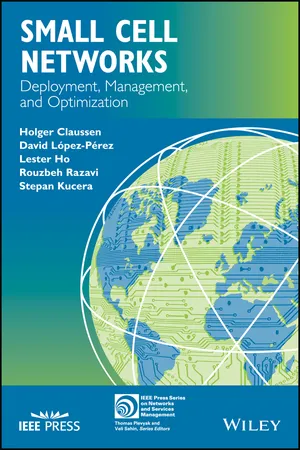
Small Cell Networks
Deployment, Management, and Optimization
Holger Claussen, David Lopez-Perez, Lester Ho, Rouzbeh Razavi, Stepan Kucera
- English
- ePUB (handyfreundlich)
- Über iOS und Android verfügbar
Small Cell Networks
Deployment, Management, and Optimization
Holger Claussen, David Lopez-Perez, Lester Ho, Rouzbeh Razavi, Stepan Kucera
Über dieses Buch
The first and only up-to-date guide offering complete coverage of HetNets—written by top researchers and engineers in the field
Small Cell Networks: Deployment, Management, and Optimization addresses key problems of the cellular network evolution towards HetNets. It focuses on the latest developments in heterogeneous and small cell networks, as well as their deployment, operation, and maintenance. It also covers the full spectrum of the topic, from academic, research, and business to the practice of HetNets in a coherent manner. Additionally, it provides complete and practical guidelines to vendors and operators interested in deploying small cells.
The first comprehensive book written by well-known researchers and engineers from Nokia Bell Labs, Small Cell Networks begins with an introduction to the subject—offering chapters on capacity scaling and key requirements of future networks. It then moves on to sections on coverage and capacity optimization, and interference management. From there, the book covers mobility management, energy efficiency, and small cell deployment, ending with a section devoted to future trends and applications. The book also contains:
- The latest review of research outcomes on HetNets based on both theoretical analyses and network simulations
- Over 200 sources from 3GPP, the Small Cell Forum, journals and conference proceedings, and all prominent topics in HetNet
- An overview of indoor coverage techniques such as metrocells, picocells and femtocells, and their deployment and optimization
- Real case studies as well as innovative research results based on both simulation and measurements
- Detailed information on simulating heterogeneous networks as used in the examples throughout the book
Given the importance of HetNets for future wireless communications, Small Cell Networks: Deployment, Management, and Optimization is sure to help decision makers as they consider the migration of services to HetNets. It will also appeal to anyone involved in information and communication technology.
Häufig gestellte Fragen
Information
Part I
Introduction
1
Small Cells—The Future of Cellular Networks
1.1 Introduction
“Any sufficiently advanced technology is indistinguishable from magic.”—Arthur C. Clarke, Profiles of the Future
- Ultra broadband wireless access, providing orders of magnitude improved performance and quality-of-service control, as well as
- A flexible and programmable cloud computing infrastructure located close to the edge of the wireless network.
1.2 The Industry Challenge

1.3 Are Small Cells the Answer?
1.3.1 Dimensions for Capacity Scaling and Historic Capacity Gains

Inhaltsverzeichnis
- Cover
- IEEE Press
- Title page
- Copyright
- ABOUT THE AUTHORS
- FOREWORD
- ACRONYMS
- PART I INTRODUCTION
- PART II COVERAGE AND CAPACITY OPTIMIZATION
- PART III INTERFERENCE MANAGEMENT
- PART IV MOBILITY MANAGEMENT AND ENERGY EFFICIENCY
- PART V SMALL CELL DEPLOYMENT
- PART VI FUTURE TRENDS AND APPLICATIONS
- A SIMULATING HETNETS
- INDEX
- IEEE Press Series on: Networks and Services Management
- EULA